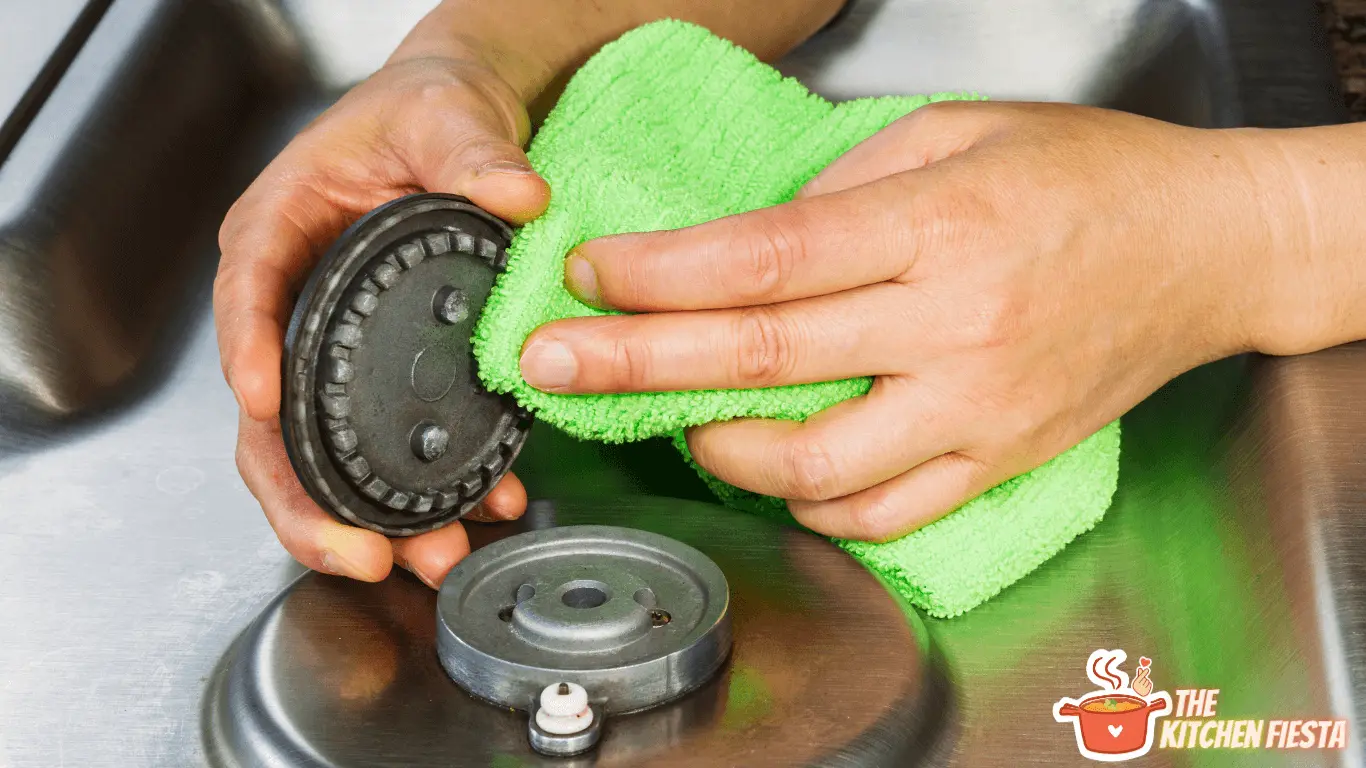How to Safely Disconnect a Gas Stove: A Step-by-Step Guide

Disconnecting a gas stove may seem daunting, but it can be done safely and efficiently with the right tools and knowledge. In this article, we will guide you through disconnecting a gas stove step by step.
Before we begin, it is important to note that improperly handling gas appliances can be dangerous. If you are uncomfortable working with gas appliances, it is best to seek the help of a professional. However, if you are confident and follow the steps carefully, you can safely disconnect your gas stove.
The first step in disconnecting a gas stove is to turn off the gas supply valve. This valve is typically located behind the stove and can be turned off by rotating it clockwise. Once the gas supply is turned off, you can disconnect the gas line from the stove.
Understanding Gas Stove Components
Gas stoves are a common household appliance that many people use for cooking. Before learning how to disconnect a gas stove, it’s important to understand the different components that make up the stove.
1. Burners
The burners are part of the gas stove where the flames come out, and the cooking occurs. Most gas stoves have four burners, but some may have more or fewer. Each burner has a knob that controls the gas flow and ignites the flame.
2. Gas Lines
The gas lines are the pipes that bring natural gas or propane into the stove. They are typically made of metal and are connected to the stove with fittings. The gas lines are usually located at the back of the stove and may be covered by a metal plate.
3. Igniter
The igniter is the component that creates a spark to light the gas flame. It is usually located near the burners and activated when the knob is turned. Some gas stoves have a pilot light instead of an igniter, a small flame that stays lit constantly and ignites the gas when the burner is turned on.
4. Regulator
The regulator is a component that controls the pressure of the gas coming into the stove. It is usually located near the gas lines and is connected to the gas supply. The regulator ensures that the gas pressure is at the correct level for the safe and efficient operation of the stove.
Understanding the different components of a gas stove is important when disconnecting it. You can safely and effectively disconnect the stove from the gas supply by knowing where the gas lines, burners, igniter, and regulator are located.
Safety Precautions
When disconnecting a gas stove, safety should be our top priority. Here are some safety precautions we should take:
- Please turn off the gas supply: We should turn off the gas supply valve before disconnecting the stove. This valve is usually located behind the stove or in the basement. We should ensure the valve is completely turned off to avoid gas leaks.
- Ventilate the area: We should open windows or doors and turn on fans to ventilate the area. This will help to prevent the buildup of gas in the room.
- Wear protective gear: We should wear protective gear like gloves and safety glasses to avoid injuries while disconnecting the stove.
- Use a gas leak detector: We should use a gas leak detector to check for any gas leaks. This will help ensure that the area is safe before disconnecting the stove.
- Keep a fire extinguisher nearby: We should keep a fire extinguisher nearby in case of emergencies. This will help to prevent any potential fires.
Tools Required
We will need a few tools to disconnect a gas stove to ensure the process is done safely and efficiently. Here are the tools that we will need:
- Adjustable wrench – We will use an adjustable wrench to disconnect the gas line from the stove. This tool will allow us to adjust the wrench size to fit the gas line nut.
- Pipe wrench – We will use a pipe wrench to loosen and tighten the gas line nut that connects the gas line to the gas valve. This tool will provide us with a better grip and leverage to turn the nut.
- Gas leak detector solution – We must ensure no gas leaks before disconnecting the gas line. We will use a gas leak detector solution to check for any leaks. This solution will bubble up if there is a leak, making it easy to identify the source of the leak.
- Safety goggles: Safety goggles will protect our eyes from any debris that may fly off during disconnection.
- Gloves: We will wear gloves to protect our hands from any sharp edges or hot surfaces.
By using these tools, we can ensure that we disconnect the gas stove safely and efficiently.
Shutting off the Gas Supply
1. Locating the Gas Valve
We first need to locate the gas valve to disconnect a gas stove. The gas valve is usually located behind the stove, near the wall. It may be a lever or a knob that you can turn to shut off the gas supply.
If you have trouble locating the gas valve, check the owner’s manual or contact a professional. It’s important to locate the gas valve before attempting to turn off the gas supply.
2. Turning off the Gas Valve
Once you have located the gas valve, we can turn it off. If it’s a lever, we can simply turn it to the off position. If it’s a knob, we may need to push and turn it to the off position.
Ensure that the gas valve is completely turned off. We can check this by turning on a burner on the stove and seeing if the flame goes out. If it doesn’t, the gas valve may not be completely turned off, and we should try turning it again.
After the gas valve is turned off, we should also unplug the stove from the electrical outlet to ensure no power is going to the stove.
Disconnecting the Gas Line
1. Loosening the Connector
We must first turn off the gas supply to disconnect the gas stove. Once that’s done, we can start loosening the connector that attaches the gas line to the stove. We can use an adjustable wrench to turn the connector counterclockwise until it’s loose enough to remove by hand.
We should never use a wrench on the gas line, which can damage the line and cause a gas leak. Instead, we should only use the wrench on the connector.
2. Separating the Gas Line
After the connector is loose, we can separate the gas line from the stove by gently pulling it away. We should be careful not to damage the gas line or the stove while doing this. If the gas line is stuck, we can use a small amount of lubricant to help loosen it.
Once the gas line is disconnected, we should cap the gas line to prevent any gas leaks. We can use a cap specifically designed for gas lines, which can be found at most hardware stores.
Removing the Stove
1. Lifting the Stove
To remove the gas stove, we need to lift it from its current position. First, we must ensure that the gas supply is turned off and the stove is cool. Removing pots, pans, or other items from the stovetop is also important.
Next, we should locate the leveling legs at the bottom of the stove. These legs are usually adjustable and can be turned to raise or lower the stove. We can turn the legs counterclockwise to lower them and clockwise to raise them.
Once the legs are adjusted, we can begin lifting the stove. Lifting with our legs and not our back is important to avoid injury. We can also ask for help from another person to make the lifting process easier.
2. Moving the Stove Safely
Once the stove is lifted, we can move it to its new location. We should be careful not to scratch the floor, walls, or other surfaces during the move. We can use furniture sliders or cardboard to protect the floor and make the move smoother.
When moving the stove, it’s important to keep it upright to avoid damaging the gas lines or other components. We should also avoid tilting the stove too much, as this can cause gas to leak out.
Once the stove is moved to its new location, we can lower it back onto its leveling legs. Before reconnecting the gas supply, we should ensure the stove is level and secure.
With these steps, we can safely and effectively remove a gas stove from its current location and move it to a new one.
Final Check
Before disconnecting your gas stove, it’s important to perform a final check to ensure everything has been done properly. Here are a few things to keep in mind:
- Make sure that all of the gas valves are turned off. This includes both the main valve and any individual valves that may be located near the stove.
- Check all the connections to ensure they are tight and secure. This includes the gas line, the regulator, and the stove’s gas inlet.
- Inspect the gas line for any signs of damage or wear. If you notice any cracks, kinks, or other issues, replace the line before reusing the stove.
- Test the stove to make sure that it is no longer receiving gas. You can do this by turning on one of the burners and waiting a few seconds. The stove is safe to use if you don’t smell any gas.
Professional Assistance
Suppose you are uncomfortable working with gas appliances or need help with disconnecting your gas stove. In that case, it is best to seek professional assistance. Gas appliances can be dangerous if not handled properly, and a mistake during the disconnection process could result in a gas leak or other safety hazard.
Choose a licensed and experienced technician. Look for a technician who specializes in gas appliance installation and repair and has a good reputation in your area. You can ask for recommendations from friends and family or search online for reviews and ratings.
Before hiring a technician, ask about their experience and credentials. They should be able to provide proof of their license and insurance and references from past clients. It would help if you also asked about their pricing and any guarantees or warranties they offer.
When the technician arrives, make sure to explain the situation clearly and provide any necessary information about your gas stove and its installation. They should be able to disconnect the stove safely and efficiently, and they may also be able to provide advice on the best way to dispose of the stove or install a new one.
Frequently Asked Questions
Who Can Disconnect A Gas Stove?
Disconnecting a gas stove should only be done by a licensed professional. Ensuring that the person doing the work is qualified and experienced in handling gas appliances is important.
Do I Need A Plumber To Disconnect A Gas Stove?
While a plumber may be able to disconnect a gas stove, hiring a licensed professional specializing in gas appliances is recommended. They will have the necessary skills and knowledge to safely disconnect the gas supply and properly cap the gas line.
Will The Gas Company Disconnect My Stove?
No, the gas company is not responsible for disconnecting a gas stove. It is the homeowner’s responsibility to hire a licensed professional to handle the disconnection.
How Do You Turn Off And Disconnect A Gas Stove?
To turn off and disconnect a gas stove, first turn off the gas supply valve located behind the stove. Then, disconnect the gas line from the stove and cap the gas line. Following all safety procedures and guidelines is important to ensure a safe disconnection.
Can You Disconnect Your Gas Stove?
No, it is not recommended to disconnect your gas stove. This should only be done by a licensed professional with the necessary skills and knowledge to handle gas appliances safely.
How Much Does It Cost To Disconnect A Gas Stove?
The cost to disconnect a gas stove can vary depending on the location and complexity of the job. Getting a quote from a licensed professional before proceeding with the disconnection is recommended.





